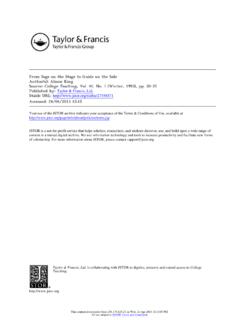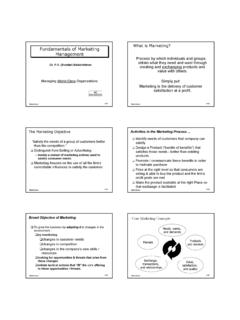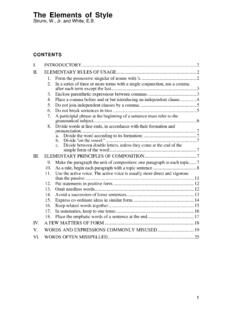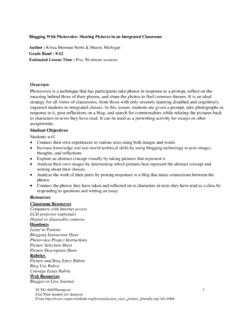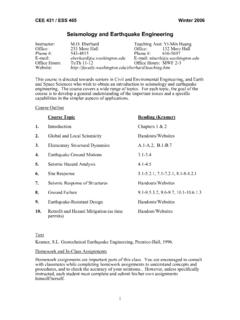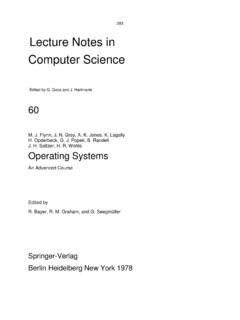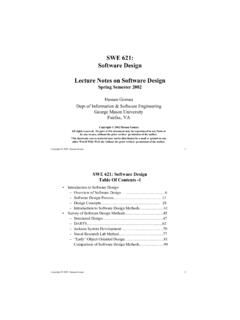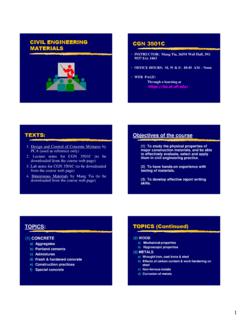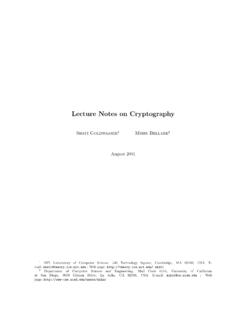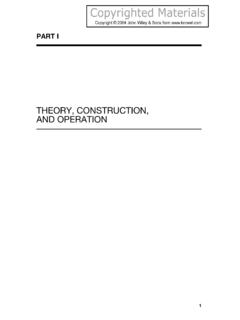Transcription of Lecture 15 Project Management - University of Washington
1 I S 460 Lecture notes Professor Yong Tan Lecture 15 Project Management Project and Project Management A Project is a [temporary] sequence of unique, complex, and connected activities having one goal or purpose and that must be completed by specific time, within budget, and according to specification. Project Management is the process of scoping, planning, staffing, organizing, directing, and controlling the development of an acceptable system at a minimum cost within a specified time frame. Measures of Project Success The resulting information system is acceptable to the customer.
2 The system was delivered on time.. The system was delivered within budget.. The system development process had a minimal impact on ongoing business operations. Causes of Project Failure Failure to establish upper- Management commitment to the Project Lack of organization's commitment to the system development methodology Taking shortcuts through or around the system development methodology Poor expectations Management Premature commitment to a fixed budget and schedule Poor estimating techniques Overoptimism The mythical man-month (Brooks, 1975).
3 Inadequate people Management skills Failure to adapt to business change Insufficient resources Failure to manage to the plan . Why is Software Project Management Difficult? Summerville (1992). The product is intangible Hard to monitor progress and assess quality No clear understanding of the underlying process Rely on process models Software systems are often one-off' Project Critical and innovative in nature Makes it hard to accumulate experience and to produce useful data 1/4. I S 460 Lecture notes Professor Yong Tan Project Management Tools & Techniques A PERT chart is a graphical network model that depicts a Project 's tasks and the relationships between those tasks.
4 Program Evaluation and Review Technique A Gantt chart is a simple horizontal bar chart that depicts Project tasks against a calendar. Each bar represents a named Project task. The tasks are listed vertically in the left-hand column. The horizontal axis is a calendar timeline. Joint Project Planning Strategy Joint Project planning (JPP) is a strategy wherein all stakeholders in a Project (meaning system owners, users, analysts, designers, and builders) participate in a one-to-three day Project Management workshop, the result of which is consensus agreement on Project scope, schedule, resources, and budget.
5 (Of course, subsequent workshops or meetings may be required to adjust scope, budget, and schedule.). Project Management Functions Scoping Planning Estimating Scheduling Organizing Directing Controlling Closing Activity 1: Negotiate Scope Scope defines the boundaries of a Project What part of the business is to be studied, analyzed, designed, constructed, implemented, and ultimately improved? Product Quality Time Cost Resources A statement of work is a narrative description of the work to be performed as part of a Project . Common synonyms include scope statement, Project definition, Project overview, and document of understanding.
6 Activity 2: Identify Tasks A work breakdown structure (WBS) is a hierarchical decomposition of the Project into phases, activities, and tasks. Milestones are events that signify the accomplishment or completion of major deliverables during a Project . 2/4. I S 460 Lecture notes Professor Yong Tan Activity 3: Estimate Task Durations 1. Estimate the minimum amount of time it would take to perform the task. We'll call this the optimistic duration (OD). 2. Estimate the maximum amount of time it would take to perform the task. We'll call this the pessimistic duration (PD).
7 3. Estimate the expected duration (ED) that will be needed to perform the task. 4. Calculate the most likely duration (D) as follows: Activity 4: Specify Intertask Dependencies Finish-to-start (FS) The finish of one task triggers the start of another task. Start-to-start (SS) The start of one task triggers the start of another task. Finish-to-finish (FF) Two tasks must finish at the same time. Start-to-finish (SF) The start of one task signifies the finish of another task. Scheduling Strategies Forward scheduling establishes a Project start date and then schedules forward from that date.
8 Based on the planned duration of required tasks, their interdependencies, and the allocation of resources to complete those tasks, a projected Project completion date is calculated. Reverse scheduling establishes a Project deadline and then schedules backward from that date. Essentially, tasks, their duration, interdependencies, and resources must be considered to ensure that the Project can be completed by the deadline. Activity 5: Assign Resources People inclusive of all the system owners, users, analysts, designers, builders, external agents, and clerical help that will be involved in the Project in any way, shape, or form.
9 Services a service such as a quality review that may be charged on a per use basis. Facilities and equipment including all rooms and technology that will be needed to complete the Project . Supplies and materials everything from pencils, paper, notebooks, toner cartridges, etc. Money A translation of all of the above into the language of accounting budgeted dollars! Resource leveling is a strategy used to correct resource over-allocations by some combination of delaying or splitting tasks. There are two techniques for resource leveling: task delaying task splitting Task Splitting and Delaying The critical path for a Project is that sequence of dependent tasks that have the largest sum of most likely durations.
10 The critical path determines the earliest possible completion date of the Project . Tasks that are on the critical path cannot be delayed without delaying the entire Project schedule. To achieve resource leveling, critical tasks can only be split. 3/4. I S 460 Lecture notes Professor Yong Tan The slack time available for any noncritical task is the amount of delay that can be tolerated between the starting time and completion time of a task without causing a delay in the completion date of the entire Project . Tasks that have slack time can be delayed to achieve resource leveling Activity 6: Direct the Team Effort Supervision resources The DEADLINE A Novel About Project Management The One Minute Manager The Care and Feeding of Monkeys Stages of Team Maturity Activity 7: Monitor and Control Progress Progress reporting Change Management Expectations Management Schedule adjustments critical path analysis (CPA).
